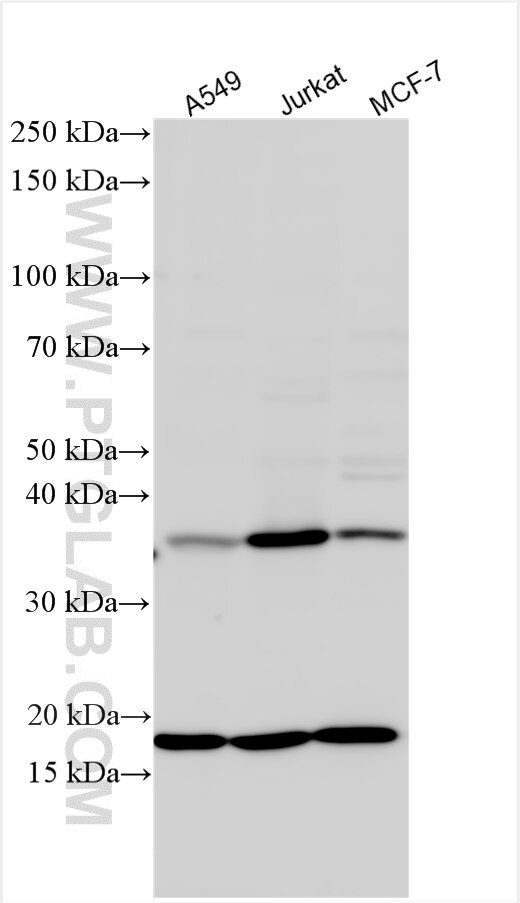GNB1L Polyclonal antibody
GNB1L Polyclonal Antibody for WB, ELISA
Host / Isotype
Rabbit / IgG
Reactivity
human
Applications
WB, ELISA
Conjugate
Unconjugated
Cat no : 26484-1-AP
Synonyms
Validation Data Gallery
Tested Applications
| Positive WB detected in | A549 cells, Jurkat cells, MCF-7 cells |
Recommended dilution
| Application | Dilution |
|---|---|
| Western Blot (WB) | WB : 1:500-1:2000 |
| It is recommended that this reagent should be titrated in each testing system to obtain optimal results. | |
| Sample-dependent, Check data in validation data gallery. | |
Product Information
26484-1-AP targets GNB1L in WB, ELISA applications and shows reactivity with human samples.
| Tested Reactivity | human |
| Host / Isotype | Rabbit / IgG |
| Class | Polyclonal |
| Type | Antibody |
| Immunogen | GNB1L fusion protein Ag24391 |
| Full Name | guanine nucleotide binding protein (G protein), beta polypeptide 1-like |
| Calculated Molecular Weight | 327 aa, 36 kDa |
| Observed Molecular Weight | 36 kDa, 18 kDa |
| GenBank Accession Number | BC012060 |
| Gene Symbol | GNB1L |
| Gene ID (NCBI) | 54584 |
| Conjugate | Unconjugated |
| Form | Liquid |
| Purification Method | Antigen affinity purification |
| Storage Buffer | PBS with 0.02% sodium azide and 50% glycerol pH 7.3. |
| Storage Conditions | Store at -20°C. Stable for one year after shipment. Aliquoting is unnecessary for -20oC storage. 20ul sizes contain 0.1% BSA. |
Background Information
GNB1L (G-protein subunit beta 1 like), located at 22q11.2, encodes a G-protein L-subunit-like polypeptide which is a member of the WD repeat protein family (PMID: 20538345). In humans, the hemizygous deletion of GNB1L can cause sensorimotor gating defects, which are related to schizophrenia and other serious mental diseases (PMID: 32847500). Moreover, GNB1L is a key regulator of DDR signaling via its role as a co-chaperone specifically regulating PIKK proteins (PMID: 37541219). GNB1L has 2 isoforms 36 kDa and 22 kDa, about 22 kDa which may be produced by Alternative splicing.
Protocols
| Product Specific Protocols | |
|---|---|
| WB protocol for GNB1L antibody 26484-1-AP | Download protocol |
| Standard Protocols | |
|---|---|
| Click here to view our Standard Protocols |


